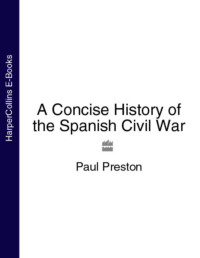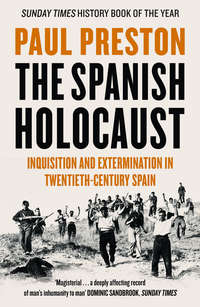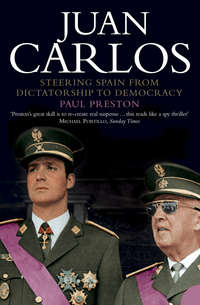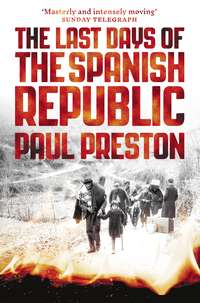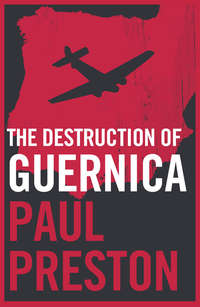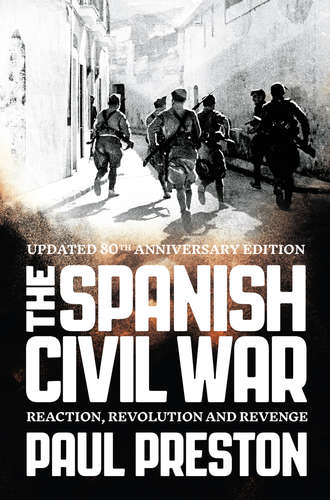
Полная версия
The Spanish Civil War: Reaction, Revolution and Revenge
Throughout 1932, the FNTT worked hard to contain the growing desperation of its southern rank and file. With agrarian reform in the air, the landowners did not feel disposed to invest in their land. The law of obligatory cultivation was effectively ignored and labour was not hired to do the tasks essential for the spring planting. Braceros were refused work because they belonged to the landworkers’ union. Nonetheless, the FNTT continued to adhere to a moderate line, and appealed to grass-roots militants to refrain from extremism and not to expect too much from the forthcoming agrarian reform. Unfortunately, the statute did little largely because its cautious provisions had been drawn up for Marcelino Domingo, the new Minister of Agriculture, by conservative agronomists and property lawyers. After painfully slow progress through the Cortes between July and September, it provided for the setting up of an Institute of Agrarian Reform to supervise the break-up of estates over 56 acres (22.5 hectares). Therefore it did absolutely nothing for the smallholders of the north. Moreover, the devices used by landowners to avoid declaring their holdings, together with the fact that the reform law’s provisions were riddled with loopholes and exceptions, ensured that it did little for the labourers of the south either. Largo Caballero described it as ‘an aspirin to cure an appendicitis’. And, if it did nothing to abate the revolutionary fervour of the countryside, it did even less to allay the hostility of right-wing landowners towards the Republic.
Another source of fierce opposition to the Republic was the statute of Catalan autonomy. Providing for Catalan control of local administration with a local parliament, the Generalitat, the statute was regarded by the army and the conservative classes as an attack on national unity. In the Cortes, a determined Azaña battled it out with right-wing deputies. In fact, the statute of Catalan autonomy, drawn up by a coalition headed by Francesc Macià, the intransigent Catalan nationalist, was far from the maximalism that had been expected by the Madrid politicians. Nevertheless, they were loath to allow the Generalitat, and particularly Macià, any real autonomy. They regarded his party, the Esquerra, as a short-lived, opportunistic coalition, dependent for its viability on the votes of the CNT rank and file. This did not prevent the right from presenting Azaña’s cabinet as hell bent on destroying centuries of Spanish unity.
However, religion remained the most potent weapon in the right-wing armoury and, to a certain extent, it was put there by Republican and Socialist imprudence. Indeed, justification for blanket hostility to the Republic could easily be found in various manifestations of anti-clericalism. Given the Church’s historic association with, and legitimization of, the most reactionary elements in Spanish society, it was not difficult to understand the extent of popular anti-clericalism. However, considerable distress was caused to ordinary Catholics by many measures which did not attack the institutional Church so much as the shared rituals that were so important in much of provincial life. Municipal authorities were forbidden to make financial contributions to the Church or its festivals. In many towns and villages the banning of religious processions was gratuitously provocative. When processions did take place, they often clashed with new laic festivals. In Seville, fear of attack led to more than forty of the traditional fraternities (cofradías) withdrawing from the Holy Week procession in the city. Many, but not all, of the members of the cofradías were militants of Acción Popular and of the Carlist Comunión Tradicionalista. Their gesture led to the popularization of the phrase ‘Sevilla la mártir’, despite the fact that every effort was made by Republican authorities to see that the processions went ahead. The issue was manipulated politically to foment hostility to the Republic by creating the impression of religious persecution.
In January 1932, Church cemeteries passed under the jurisdiction of municipalities. There were cases of left-wing mayors (alcaldes) imposing a tax on Catholic burials or funeral processions being prohibited altogether. The state recognized only civil marriage, so those who had a Church wedding were required to visit a registry office. The removal of crucifixes from schools and of religious statues from public hospitals, along with the prohibition on the ringing of bells, caused ordinary Catholics to see the Republic as their enemy. There were many cases of left-wing alcaldes placing a local tax on the ringing of bells, to make the Church contribute to social welfare. Religious friction at both local and national level created an ambience that rightist politicians found easy to exploit. The attribution of the Republic’s reforming ambitions to a sinister foreign Jewish–Masonic–Bolshevik plot went hand in hand with claims that it must be destroyed and its supporters exterminated.
Indeed, the right soon demonstrated that it would not scruple to use violence to change the course of the Republic. Army officers enraged by the military reforms and autonomy statute were joined by monarchist plotters in persuading General José Sanjurjo that the country was on the verge of anarchy and ready to rise at his bidding. General Sanjurjo’s attempted coup took place on 10 August 1932. Badly planned, it was easily defeated both in Seville, by a general strike of CNT, UGT and Communist workers, and in Madrid, where the government, warned in advance, quickly rounded up the conspirators. In a sense, this attack on the Republic by one of the heroes of the old regime, a monarchist general, benefited the government by generating a wave of pro-Republic fervour. The ease with which the Sanjurjada, as the fiasco was known, was snuffed out enabled the government to generate enough parliamentary enthusiasm to get the agrarian reform bill and the Catalan statute of autonomy through the Cortes that September. Nevertheless, among those who supported the coup were the same rightists who had taken part in the shootings in the Parque de María Luisa in Seville in 1931. They would soon be at liberty and with plenty of time to repeat their exploits in 1936.
The government’s prestige was at its height yet the situation was much less favourable than it appeared. The Sanjurjada showed the hostility with which the army and the extreme right regarded the Republic. Moreover, while the government coalition was crumbling, the right was organizing its forces. This process was aided by the insurrectionism of the CNT. The rightist press did not make subtle distinctions between the CNT, the UGT and the FNTT. Although the CNT regarded the Republic as being ‘as repugnant as the monarchy’, its strikes and uprisings were blamed on the Republican–Socialist coalition which was working hard to control them. However, while the extreme right in the pueblos (villages) was content to engage in blanket condemnation of disorder, the more far-sighted members of the rural bourgeoisie, who had found a home in the Radical Party, were able to use the CNT’s hostility towards the Socialists in order to drive wedges between the different working-class organizations. The most dramatic example of this process took place as a result of a nationwide revolutionary strike called by the CNT for 8 January 1933 and of its bloody repercussions in the village of Casas Viejas in the province of Cádiz. In the lockout conditions of 1932, four out of five workers in Casas Viejas were unemployed for most of the year, dependent on charity, occasional road-mending jobs and scouring the countryside for food in the shape of wild asparagus and rabbits. Their desperation, inflamed by an increase in bread prices, ensured a ready response on 11 January to the earlier CNT call for revolution. Their hesitant declaration of libertarian communism led to savage repression in which twenty-four people died.
The rightist press moved swiftly from issuing congratulations to the forces of order to a realization that the situation could be exploited. The subsequent smear campaign, in which the right-wing papers howled that the Republic was as barbaric, unjust and corrupt as all the previous regimes, ate into the morale of the Republican–Socialist coalition. The work of the government was virtually paralysed. Although the Socialists stood loyally by Azaña, who bore the brunt of rightist abuse for Casas Viejas, the incident heralded the death of the coalition, symbolizing as it did the government’s failure to resolve the agrarian problem. Henceforth, at a local level, the FNTT was to become more belligerent and its attitude filtered through into the Socialist Party in the form of a rejection of collaboration with the Republicans. The anarchists, meanwhile, stepped up the tempo of their revolutionary activities. The Radicals under Lerroux, ever-anxious for power, drew increasingly to the right and began a policy of obstruction in the Cortes.
The latent violence at local level was transmitted to national politics, where there developed increasing hostility between the PSOE and the newly created rightist group, the Confederación Española de Derechas Autónomas (CEDA). The new party, which had grown out of Acción Popular and at least forty other rightist groups, was the creation of José María Gil Robles. In his closing speech at the founding congress in Madrid, in February 1933, he told his audience:
When the social order is threatened, Catholics should unite to defend it and safeguard the principles of Christian civilization … We will go united into the struggle, no matter what it costs … We are faced with a social revolution. In the political panorama of Europe I can see only the formation of Marxist and anti-Marxist groups. This is what is happening in Germany and in Spain also. This is the great battle which we must fight this year.
Later on the same day, at another meeting in Madrid, he said that he could not see anything wrong with thinking of fascism to cure the evils of Spain. The Socialists were convinced that the CEDA was likely to fulfil a Fascist role in Spain, a charge only casually denied by the Catholic party, if at all. A majority in the PSOE led by Largo Caballero came to feel that if bourgeois democracy was incapable of preventing the rise of fascism, it was up to the working class to seek different political forms with which to defend itself.
In the meanwhile, throughout 1933, the CEDA was spreading discontent with the Republic in agrarian circles. Gil Robles specialized in double-edged pronouncements, and fuelled the Socialists’ sensitivity to the danger of fascism. Weimar was persistently cited as an example by the right and as a warning by the left. Parallels between the German and Spanish Republics were not difficult to find. The Catholic press applauded the Nazi destruction of the German Socialist and Communist movements. Nazism was much admired on the Spanish right because of its emphasis on authority, the fatherland and hierarchy – all three central preoccupations of CEDA propaganda. More worrying still was that, in justification of the legalistic tactic in Spain, El Debate pointed out that Hitler had attained power legally. The paper frequently commented on Spain’s need for an organization similar to those which had destroyed the left in Germany and Italy, and hinted that Acción Popular/CEDA could fulfil that role.
It was in such an atmosphere that elections were called for November. In contrast to 1931, this time the left went to the polls in disarray. The right, on the other hand, was able to mount a united and generally bellicose campaign. Gil Robles had just returned from the Nuremberg rally and appeared to be strongly influenced by what he had seen. Indeed, the CEDA election campaign showed that Gil Robles had learned his lessons well. Determined on victory at any price, the CEDA election committee decided for a single anti-Marxist counterrevolutionary front. Thus, the CEDA had no qualms about going into the elections in coalition with ‘catastrophist’ groups such as Renovación Española and the Carlists or, in other areas, with the cynical and corrupt Radicals.
A vast amount of money was spent on the right’s election campaign. The CEDA’s election fund was enormous, based on generous donations from the well-to-do like Juan March, the millionaire enemy of the Republic. The climax of the CEDA’s campaign came in a speech given in Madrid by Gil Robles. His tone could only make the left wonder what a CEDA victory might mean for them:
We must reconquer Spain … We must give Spain a true unity, a new spirit, a totalitarian polity … It is necessary now to defeat socialism inexorably. We must found a new state, purge the fatherland of judaising freemasons … We must proceed to a new state and this imposes duties and sacrifices. What does it matter if we have to shed blood! … We need full power and that is what we demand … To realize this ideal we are not going to waste time with archaic forms. Democracy is not an end but a means to the conquest of the new state. When the time comes, either parliament submits or we will eliminate it.
The Socialists, who had decided to contest the elections on their own, could not match the massive propaganda campaign mounted by the right. Gil Robles dominated the campaign of the rightist coalition, as Largo Caballero did that of the Socialists, mirroring the radical extremism of his opponent. Declaring that only the dictatorship of the proletariat could carry out the necessary economic disarmament of the bourgeoisie, he delighted his supporters but antagonized the right and helped justify its already aggressive stance.
The arguments of the moderate Indalecio Prieto that the PSOE must maintain its electoral alliance with the left Republicans were dismissed by the more radical elements of the party led by Largo Caballero. Their imposition of the decision to go it alone was an irresponsible one. They were simultaneously blaming the left Republicans for all the deficiencies of the Republic and confidently assuming that all the votes cast in 1931 for the victorious Republican–Socialist coalition would stay with the PSOE. In fact, that coalition had ranged from the middle classes to the anarchists. The Radicals were now on the right and, in the wake of Casas Viejas, the hostility of the anarchists to the Republic ensured that they would abstain. The Socialists were committing a fatal tactical error. Given the existing electoral law which favoured coalitions, together with the CEDA’s readiness to make alliances, it took twice as many Socialist votes to elect a deputy as rightist ones. The election results brought bitter disappointment to the Socialists, who won only fifty-eight seats. After local deals between the CEDA and the Radicals designed to take advantage of the electoral law, the two parties finished with 115 and 104 deputies respectively. The right had regained control of the apparatus of the state. It was determined to use it to dismantle the reforms of the previous two years. However, expectations had been raised during that time which could only ensure burning popular fury when the right put back the clock to the days before 1931.
THREE
Confrontation and Conspiracy, 1934–1936
In the following two years, which came to be known as the bienio negro (black two years), Spanish politics were to be bitterly polarized. The November 1933 elections had given power to a right wing determined to avenge the injuries and indignities which it felt it had suffered during the period of the Constituent Cortes. This made conflict inevitable, since, if the workers and peasants had been driven to desperation by the inadequacy of the reforms of 1931–2, then a government set on destroying these reforms could only force them into violence. At the end of 1933, 12 per cent of Spain’s workforce was unemployed and in the south the figures were nearer 20 per cent. Employers and landowners celebrated the victory by cutting wages, sacking workers, evicting tenants and raising rents. Even before a new government had taken office, labour legislation was being blatantly ignored.
The Socialists’ outrage knew no bounds. Their own tactical error in not allying with the Republicans had made a crucial contribution to their electoral defeat. However, the PSOE was convinced that the elections had been fraudulent. In the south, they had good reason to believe that they had been swindled out of seats by the caciques’ power over the starving braceros. In rural areas of high unemployment, it had been easy to secure votes by the promise of jobs or the threat of dismissal. Armed thugs employed by the caciques prevented Socialist campaigners speaking at some meetings and were a louring presence next to the glass voting urns on election day. In Spain as a whole, the PSOE’s one and a half million votes had won it 58 seats in the Cortes, while the Radicals’ eight hundred thousand votes had been rewarded with 104 seats. According to calculations made by the PSOE, the united parties of the right had together got 3,345,504 votes and 212 seats at 15,780 votes per seat, while the disunited left had received 3,375,432 votes and only ninety-nine seats at 34,095 votes per seat. In some areas of the south – Badajoz, Córdoba and Málaga, for example – the margin of right-wing victory was small enough for electoral malpractice to have made all the difference. Rank-and-file bitterness at the cynical union of Radicals with the CEDA and at losing the elections unfairly quickly gave way to dismay at the untrammelled offensive of the employers. Popular outrage was all the greater because of the restraint and self-sacrifice that had characterized Socialist policy between 1931 and 1933. Now, in response to the consequent wave of militancy, the Socialist leadership began to adopt a tactic of revolutionary rhetoric. Their vain hope was that they could both scare the right into limiting its belligerency and persuade the President of the Republic, Niceto Alcalá Zamora, to call new elections.
Although he was not prepared to go that far, Alcalá Zamora did not invite Gil Robles to form a government despite the fact that the CEDA was the biggest party in the Cortes, albeit one without an overall majority. The President suspected the Catholic leader of nurturing more or less Fascist ambitions to establish an authoritarian, corporative state. Thus, Alejandro Lerroux, as leader of the second largest party, became Prime Minister. Dependent on CEDA votes, the Radicals were to be the CEDA’s puppets. In return for harsh social policies in the interests of the CEDA’s wealthy backers, the Radicals were to be allowed to enjoy the spoils of office. The Socialists were appalled. Largo Caballero was convinced that in the Radical Party there were those who, ‘if they have not been in jail, deserve to have been’. Once in government, they set up an office to organize the sale of state favours, monopolies, government procurement orders, licences and so on. The PSOE view was that the Radicals were hardly the appropriate defenders of the basic principles of the Republic against rightist assaults.
The first violent working-class protest, however, came from the anarchists. With irresponsible naïvety, an uprising was called for 8 December 1933. However, the government had been forewarned of the anarcho-syndicalists’ plans and quickly declared a state of emergency. Leaders of the CNT and the FAI were arrested, press censorship was imposed and syndicates were closed down. In traditionally anarchist areas, Aragón, the Rioja, Catalonia, the Levante, parts of Andalusia and Galicia, there were sporadic strikes, some trains were blown up and Civil Guard posts were assaulted. The movement was quickly over in Barcelona, Madrid and Valencia. In the Aragónese capital Zaragoza, however, the rising did get off the ground. Workers raised barricades, attacked public buildings and engaged in street fighting. The response of the government was to send in the army, which took four days with the aid of tanks to crush the insurrection.
Violent incidents involving the CNT diverted attention from the growing problem of malnutrition in the southern provinces. This was a consequence not only of the determination of landowners to slash wages and refuse work to union members but also of significant rises in the price of basic necessities. The Radical government had removed controls on the price of bread and it had risen by 25 to 70 per cent. Demonstrations by starving women, children and the aged calling for bread became a frequent sight. The spread of hunger in the south was also mirrored in the intensification of militancy within the principal landworkers’ union, the FNTT. Its president, the moderate Lucio Martínez Gil, was replaced by one of the more radical young followers of Largo Caballero, Ricardo Zabalza Elorga. At the end of 1933, then, the Socialist leaders were faced with a rising tide of mass militancy, which was a consequence both of the employers’ offensive and their own feeling of bitterness at the perceived unfairness of electoral defeat. Largo Caballero reacted by intensifying his revolutionary threats although his noisy rhetoric was not matched by any serious revolutionary intentions. His was verbal revolutionism both to satisfy rank-and-file aspirations and to pressure Alcalá Zamora to call new elections. It was a dangerous game, since, if the President did not succumb to such pressure, the Socialists would be left with the choice of stepping up their threats or losing credibility with their own militants. The resulting situation could benefit only the CEDA.
With a pliant Radical government in power, the success of Acción Popular’s ‘accidentalist’ tactics could hardly have been more apparent. ‘Catastrophism’ was for the moment eclipsed. Nevertheless, the extreme right remained unconvinced by Gil Robles’ democratic tactic and so continued to prepare for violence. Carlists were collecting arms and drilling in the north and the spring of 1934 saw Fal Conde, the movement’s secretary, recruiting volunteers in Andalusia. In March, representatives of both the Carlists and the Alfonsine monarchist party, Renovación Española, led by Antonio Goicoechea, went to see Mussolini who promised money and arms for a rising. Both groups were convinced that even a strong rightist government did not constitute an adequate long-term guarantee for their interests, because it would be subject to the whims of the electorate in a still democratic Republic. In May 1934, the monarchists’ most dynamic and charismatic leader, José Calvo Sotelo, returned after three years exile to take over the leadership from Antonio Goicoechea. Henceforth, the monarchist press, in addition to abusing Gil Robles’ weakness, began increasingly to talk of the conquest of the state as the only sure road to the creation of a new authoritarian, corporative regime.
Even Gil Robles was having trouble controlling his forces. His youth movement, the Juventud de Acción Popular (JAP), was seduced by the German and Italian examples. Great Fascist-style rallies were held at which Gil Robles was hailed with the cry ‘¡Jefe! ¡Jefe! ¡Jefe!’ (the Spanish equivalent of Duce) in the hope that he might start a ‘March on Madrid’ to seize power. Monarchist hopes, however, centred increasingly on the openly Fascist group of José Antonio Primo de Rivera, Falange Española, as a potential source of shock troops against the left. The Falange had been founded in October 1933 with monarchist subsidies. As a landowner, an aristocrat and well-known socialite, José Antonio Primo de Rivera served as a guarantee to the upper classes that Spanish fascism would not get out of their control in the way of its German and Italian equivalents. Falange Española merged in 1934 with the pro-Nazi Juntas de Ofensiva Nacional-Sindicalista of the pro-German Ramiro Ledesma Ramos, becoming Falange Española de las JONS. Perpetually short of funds, the party remained during the Republican period essentially a small student group preaching a utopian form of violent nationalist revolution. The Falangist leader’s cult of violence facilitated the destabilization of the politics of the Second Republic. His blue-shirted militias, with their Roman salutes and their ritual chants of ¡ARRIBA ESPAÑA! and ¡ESPAÑA! ¡UNA! ¡ESPAÑA! ¡LIBRE! ¡ESPAÑA! ¡GRANDE!, aped Nazi and Fascist models. From 1933 to 1936, FE de las JONS functioned as the cannon fodder of the haute bourgeoisie, provoking street brawls and helping to generate the lawlessness which, exaggerated by the right-wing press, was used to justify the military rising. Its importance lay in the role played by its political vandalism in screwing up the tension which would eventually erupt into the Civil War.


